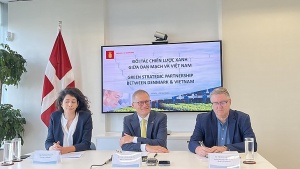Barriers must be removed for successful advances in clean and green investment
 |
| Do Van Su - Deputy director general Foreign Investment Agency Ministry of Planning and Investment |
Earlier this year, the Ministry of Planning and Investment (MPI) carried out research with Boston Consulting Group (BCG) which found that by 2050, wind power and solar power can contribute about $70-80 billion to GDP and create up to 105,000 direct jobs, while the hydrogen ecosystem may give $40-45 billion to GDP and create as much as 50,000 jobs.
Vietnam’s green economy is looking to blossom from $6.7 billion in 2020 to $300 billion by 2050. In this, the World Bank forecasts that Vietnam would need $368 billion from now to 2040, equivalent to 6.8 per cent of GDP per year, to improve resilience and decarbonise. According to the MPI and BCG, Vietnam needs $144 billion in 2021-2050, equalling 2.2 per cent of GDP.
The MPI also proposed to mobilise input capital for green growth from three main capital sources. The first is foreign aid, including the Just Energy Transition Partnership, which has pledged to provide $15.5 billion. In addition, the MPI is negotiating with numerous funds, including the Green Climate Fund, that are managing 26 project ideas with total capital of $2.3 billion, including $378 million in the non-refundable capital. The rest is expected to be mobilised from other international organisations and financial institutions.
The second source is foreign investment, which is set to lure about $20-30 billion per year between 2026 and 2030, and as much as $40 billion in 2031-2040. To increase the prospects, Vietnam is shifting from welcoming wide-ranging investment to being more selective and in-depth, focusing on high-quality green growth.
The third source comes from internal resources, including both public and private investment.
Vietnam is currently in the top 10 countries on the map in terms of luring the most green investment, accounting for 5 per cent of developing countries. The largest contribution of green foreign investment in Vietnam is renewable energy, increasing almost 6-fold over the past 10 years.
However, investors worldwide can point out some barriers when they carry out green investment in a country or region. Regarding legal policies, they are most afraid of inconsistency and ambiguity related to green investment. For example, a country may call for investment into electric vehicles with some tax reductions and incentives, but suddenly, all incentives are applied only to vehicles using hydrogen gas.
The second is the lack of supportive or clear policies, so green projects cannot be ensured the economic outcomes. Poor tech infrastructure is also a problem, especially in renewable energy, if power is generated too much but cannot be transmitted.
There is also a lack of advanced technologies and insufficient support for them to develop, high initial investment costs, ineffective access to funding mechanisms, market and consumer risks, unskilled labour sources, lack of expertise in green project management, and other social-political uncertainties.
In Vietnam in particular, barriers to attracting green investment involve shortcomings in the supply chain, infrastructure, financial capital, labour, taxes and incentives, and research and development.
Therefore, the MPI has proposed several solutions in terms of building policies and a legal framework of green financial tools in bonds, credit, and insurance. They need to be issued soon for investors to apply and develop a market for exchanging emissions rights; promulgate a green investment incentive mechanism; offer guidance in public-private partnership methods; provide solutions for concentrating resources on green credit; and upgrade corporate sustainable indicators.
Regarding investment policy, the set of criteria for selecting input efficiency has been submitted to the government for the next submission to the National Assembly for inclusion in laws and decrees, while the set of criteria for evaluating output performance, including nearly 40 groups of indicators, is also being submitted to the prime minister.
While luring in foreign investment, Vietnam should choose technology and streamline by industry and area. The country is calling for investment in electronics, components, the vehicle industry, metal and rare earths, minerals, renewable energy, and IT infrastructure. So, while it is impossible to eliminate all industries showing signs of pollution, we can choose to improve technologies to reduce pollution and raise the performance of processing and refining.
 | Green investment requires collective efforts from all Sustainability is taking centre stage in Vietnam’s development plan. Amanda Murphy, head of Commercial Banking for South and Southeast Asia at HSBC Asia-Pacific, discussed with VIR’s Luu Huong the pivotal role of public-private partnerships in facilitating green financing tools and emphasises the importance of clear policymaking for sustainable investments. |
 | Danish firms increase green investments in Vietnam Two outstanding aspects of cooperation between Denmark and Vietnam over the last few decades, green investment and renewable energy, will be boosted by the establishment of a Green Strategic Partnership. |
What the stars mean:
★ Poor ★ ★ Promising ★★★ Good ★★★★ Very good ★★★★★ Exceptional
Related Contents
Latest News
More News
- Global partnerships key to Vietnam’s IFC development (December 26, 2025 | 16:18)
- Vingroup pulls out of bid to invest in North-South high-speed railway (December 26, 2025 | 11:42)
- Strengthening supply chains through trade promotions and customs reform (December 24, 2025 | 14:00)
- PM orders investment model for North–South high-speed rail (December 22, 2025 | 17:43)
- LS Eco Energy to invest in Vietnam rare earth sector (December 22, 2025 | 17:31)
- Government moves to establish International Financial Centre (December 21, 2025 | 21:00)
- Vietnam's IFC to target global investment flows (December 21, 2025 | 18:00)
- Two national hospitals expand capacity with new facilities (December 20, 2025 | 09:00)
- Ha Tinh breaks ground on major Vingroup industrial and energy projects (December 19, 2025 | 18:24)
- EVN launches major power infrastructure projects nationwide (December 19, 2025 | 18:17)

 Tag:
Tag:





















 Mobile Version
Mobile Version